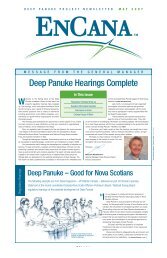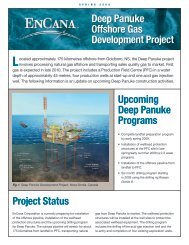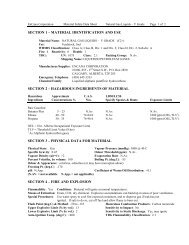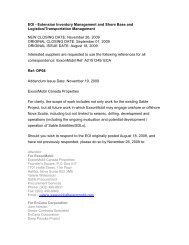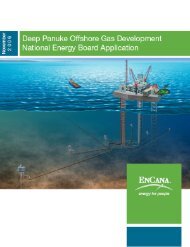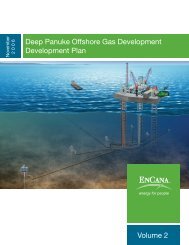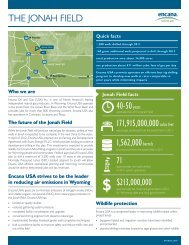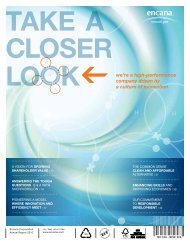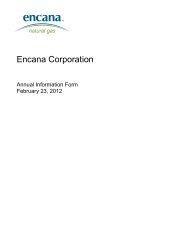Deep Panuke Project Description - Encana
Deep Panuke Project Description - Encana
Deep Panuke Project Description - Encana
You also want an ePaper? Increase the reach of your titles
YUMPU automatically turns print PDFs into web optimized ePapers that Google loves.
After carefully considering the concept, EnCana rejected the onshore processing with subsea tie-backoption as not technically feasible. There is no precedent of tie-backs of this length anywhere worldwideto date. In addition, the lack of inlet compression offshore would impact the recovery of theresource and result in a larger unrecoverable portion of the resource when compared to an offshoresolution. These technical issues and reduced resource recovery contributed to the rejection of theonshore processing with subsea tie-back option.Split Onshore/Offshore Processing (Intermediate Case)An intermediate case for onshore processing was also reviewed. The intermediate case requiresdehydration and H 2 S removal offshore, transportation to shore in a dedicated multi-phase pipeline, andseparation, dewpointing and condensate treatment occurring at the onshore facility. Under this scenario,condensate must also be treated offshore for H 2 S removal since the pipeline and the onshore facility aredesigned for processing sweet gas. Treating condensate offshore requires the same facilities as fulloffshore processing plus, additional, duplicative facilities onshore. There is no technical or economicadvantage in recombining the gas and condensate for multiphase transport since duplicate facilities forcondensate separation and treatment would be required onshore. Accordingly, the intermediate case wasrejected based on technical and economical considerations.EnCana’s proposed solution is offshore processing. The alternate pipeline case will dictate the finalconfiguration - full offshore processing under the M&NP Option or partial processing under the SOEPSubsea Option.In summary, offshore processing was selected as the preferred option based on the following:• treating and disposing of sour gas as close to source as possible and thereby reducing risk to thelocal population and environment near Goldboro;• offshore injection of acid gas minimizes safety and environmental risk due to the bufferingcapacity of the marine environment and the few receptors in the offshore project area;• reduced risk related to subsea pipeline integrity with the removal of both water and H 2 S prior totransport to shore; and• capital and operating costs.2.10.2.7 Acid Gas HandlingRemoval of H 2 S from the inlet gas stream results in a concentrated waste stream to be handled offshore.The FEED study investigated four options for handling acid gas offshore including flaring, seawaterscrubbing, offshore sulphur recovery, and acid gas injection. The alternative chosen for the <strong>Project</strong> is theacid gas injection technology. A summary of the investigation is included below and summarized in Table2.12.<strong>Deep</strong> <strong>Panuke</strong> Volume 4 (Environmental Assessment Report) • November 2006 2-70




